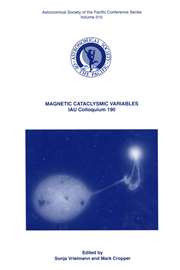No CrossRef data available.
Article contents
High-Speed Optical Spectroscopy of a Cataclysmic Variable Wind: BZ Cam (0623+71)
Published online by Cambridge University Press: 12 April 2016
Extract
The nova-like variable BZ Cam (also called 0623+71) is an unusual cataclysmic variable star in that it resides in a nebula, discovered by Ellis, Grayson, & Bond (1984) and designated EGB 4. It is more unusual in that its optical spectrum reveals a wind from its accretion disk. This was discovered serendipitously during a radial velocity study to find orbital period by Thorstensen, Thomas, & Patterson (1993; see also Patterson et al. 1996), who found intermittent P Cygni profiles in the He I λ 5876 Å and Hα emission lines.
The 4.2-m William Herschel Telescope and its ISIS spectrograph were used to obtain time-resolved spectra of these lines with 0.4 Å/pixel dispersion and 30-second time resolution. These new spectra have about 5 times the spectral resolution and 24 times the time resolution of those of Thorstensen et al. (1993). These observations were obtained on the nights of 1995 February 6 – 8 UT. The blue arm of ISIS was centered on the He I λ 5876 Å; the red arm covered Hα. Typical signal-to-noise ratio was 18 per resolution element.
Information
- Type
- Part 15. Poster Papers
- Information
- International Astronomical Union Colloquium , Volume 163: Accretion Phenomena and Related Outflows , 1997 , pp. 790 - 791
- Copyright
- Copyright © Astronomical Society of the Pacific 1997

